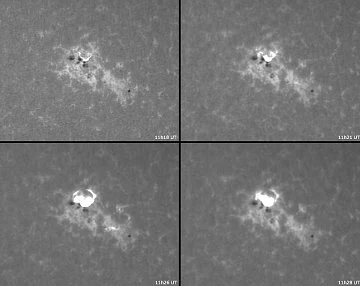 I've been trying to understand the propagation conditions that caused my little 20 mW DSB signal to be received ALL-NIGHT-LONG at a distance of 1900 km by station LA3JJ on the night of 12/13 Feb 2010 (click here for more details).
I've been trying to understand the propagation conditions that caused my little 20 mW DSB signal to be received ALL-NIGHT-LONG at a distance of 1900 km by station LA3JJ on the night of 12/13 Feb 2010 (click here for more details).A visit to spaceweather.com provided the answer. At around 1126 UTC on 12 Feb we had the brightest solar flare in more than two years: Sunspot 1046 produced an M8.3 Flare. Helge Mortensen in Norway reported that on 15 Feb in Norway there was "a fantastic blast of aurora." He took a beautiful picture of it (above). Could it be that we see in this picture particles from the same flare, or a coronal mass ejection associated with it?
One of the really cool things about the spaceweather.com site is that it includes lots of input from amateur astronomers and photographers like Helge. Emiel Veldhuis in the Netherlands happened to be observing 1046 when the M flare occurred and he took this series of shots:
 Terje Isberg in Switzerland was listening to a DRM station on sortwave. He observed and recorded the radio blackout (SID) caused by the flare:
Terje Isberg in Switzerland was listening to a DRM station on sortwave. He observed and recorded the radio blackout (SID) caused by the flare: Rogiero Marconi in Brazil took this shot of the sunspot:
Rogiero Marconi in Brazil took this shot of the sunspot: Amazing stuff. This is a good example of how WSPR really puts you in touch with solar conditions and space weather.
Amazing stuff. This is a good example of how WSPR really puts you in touch with solar conditions and space weather.
No comments:
Post a Comment